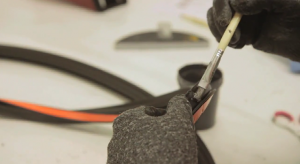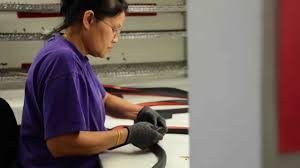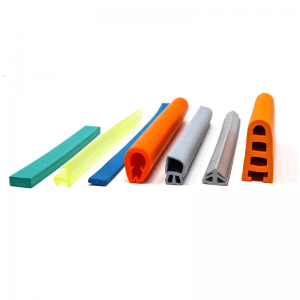 Cold bonding for rubber gaskets joins lengths of material without the use of heat. This bonding technique doesn’t require low-temperature conditions, but is called “cold” because no heat is applied to the gasket. By contrast, hot splicing requires either a conventional heat source or infrared (IR) light. Vulcanization and molded corners for rubber gaskets also involve heating gasket materials.
Cold bonding for rubber gaskets joins lengths of material without the use of heat. This bonding technique doesn’t require low-temperature conditions, but is called “cold” because no heat is applied to the gasket. By contrast, hot splicing requires either a conventional heat source or infrared (IR) light. Vulcanization and molded corners for rubber gaskets also involve heating gasket materials.
With cold bonding, an adhesive is applied to the ends of the lengths that will be joined together. Different types of bonding systems are available, including compounds that vary in terms of viscosity, chemistry, and material properties. Cold bonding for rubber gaskets can save time and eliminate tooling costs, but engineers need a complete understanding of this joining method before choosing glued gaskets.
How Cold Bonding Works
Cold bonding is a manual process that’s performed with a brush and adhesive or glue. First, production personnel prepare the surfaces of the rubber materials that will be joined. To promote optimum adhesion, some elastomers may need to be abraded. Degreasers, solvents, or other cleaning agents are sometimes used to remove dirt, oils, and other surface contaminants.
After the surfaces are wiped clean and dried carefully, the glue or adhesive is applied. Rubber bonding systems include low, medium, and high viscosity adhesives that come in cyanoacrylate, silicone, epoxy, and other formulas. Specific bonding products may be designed for elastomers such as nitrile, silicone, neoprene, or EPDM. Some glues crystallize when they contact water. All glues dry out over time.
Advantages and Disadvantages of Cold Bonding

Cold bonding is more expensive than film splicing, but this manual process combines speed with scalability. If you need a higher volume of glued gaskets, Elasto Proxy can allocate additional labor resources to your project. Our skilled production personnel understand how to create strong bonds and take pride in their craftsmanship.
At any manufacturing facility, capacity is inherently limited by the amount of equipment that’s available. Manual processes generally take longer, but adding enough labor to a project can yield higher throughputs during a unit of time such as a shift. Cold bonded gaskets won’t last as long, but choosing the right joining method means balancing requirements such as strong corners against production speed and cost.
Is Cold Bonding Right for Your Application?
Unlike molded corners for rubber gaskets, cold bonding doesn’t require dies. That’s an important consideration if you need low-volume quantities, especially for one-time production runs. Metal tooling can add significant costs to gasket fabrication – sometimes as much as tens of thousands of dollars. Unless your quantities are large enough, molded corners may be too expensive compared to cold bonding.
Determining whether cold bonding is right for your application isn’t just about understanding how the process works or how much it costs. Engineers need to analyze all the tradeoffs that are involved, especially compared to other available joining methods. By working closely with Elasto Proxy’s solutions providers, you can choose the bonding method that’s best for your gasketing application.
Gasket Bonding and Custom Fabrication
We hope you’ve enjoyed this three-part series about gasket bonding. If you’ve missed our other recent articles, we invite you to read about Hot Splicing and Vulcanizing for Rubber Gaskets and Molded Corners for Rubber Gaskets. Elasto Proxy is an experienced custom fabricator of industrial rubber products with capabilities that include design assistance, help with material selection, warehousing, and logistics.










